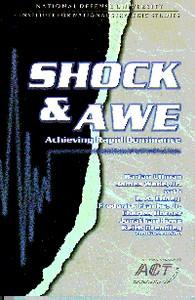Read this ebook for free! No credit card needed, absolutely nothing to pay.
Words: 42964 in 10 pages
This is an ebook sharing website. You can read the uploaded ebooks for free here. No credit cards needed, nothing to pay. If you want to own a digital copy of the ebook, or want to read offline with your favorite ebook-reader, then you can choose to buy and download the ebook.


: Shock and Awe — Achieving Rapid Dominance by Ullman Harlan Wade James P - Rapid dominance (Military science)
The purpose of this paper is to explore alternative concepts for structuring mission capability packages around which future U. S. military forces might be configured. From the very outset of this study group's deliberations, we agreed that the most useful contribution we could make would be to attempt to reach beyond what we saw as the current and commendable efforts, largely but not entirely within the Department of Defense, to define concepts for strategy, doctrine, operations, and force structure to deal with a highly uncertain future. In approaching this endeavor, we fully recognized the inherent and actual limits and difficulties in attempting to reach beyond what may prove to be the full extent of our grasp.
It is, of course, clear that U.S. military forces are currently the most capable in the world and are likely to remain so for a long time to come. Why then, many will ask, should we examine and even propose major excursions and changes if the country occupies this position of military superiority? For reasons noted in this study, we believe that excursions are important if only to confirm the validity of current defense approaches. There are several overrarching realities that have led us to this conclusion. First, while everyone recognizes that the Cold War has ended, there is not a consensus about what this means for more precisely defining the nature of our future security needs. Despite this absence of both clairvoyance and a galvanizing external danger, the United States is actively examining new strategic options and choices. The variety of conceptual efforts underway in the Pentagon to deal with this uncertainty exemplifies this reality.
At the same time, the current dominance and superiority of American military power, unencumbered by the danger of an external peer competitor, have created a period of strategic advantage during which we have the luxury of time, perhaps measured in many years, to re-examine with a margin of safety our defense posture. On the other hand, potential adversaries cannot be expected to ignore this predominant military capability of the United States and fail to try to exploit, bypass, or counter it. In other words, faced with American military superiority in ships, tanks, aircraft, weapons and, most importantly, in competent fighting personnel, potential adversaries may try to change the terms of future conflict and make as irrelevant as possible these current U.S. advantages. We proceed at our own risk if we dismiss this possibility.
Second, it is relatively clear that current U.S. military capability will shrink. Despite the pledges of the two major American political parties to maintain or expand the current level of defense capability, both the force structure and defense infrastructure are too large to be maintained at even the present levels and within the defense budgets that are likely to be approved. Unless a new menace materializes, defense is headed for "less of the same." Such reductions may have no strategic consequences. However, that is an outcome that we believe should not be left to chance.
This shrinkage also means that the Pentagon's good faith strategic reviews aimed at dealing with our future security needs may be caught up in the defense budget debate over downsizing and could too easily drift into becoming advocacy or marketing documents. As the services are forced into more jealously guarding a declining force structure, the tendency to "stove-pipe" and compartmentalize technology and special programs is likely to increase, thereby complicating the problem of making full use of our extraordinary technological resources. This means that some external thinking, removed from the bureaucratic pressures and demands, may be essential to stimulating and sustaining innovation.
Third, the American commercial-industrial base is undergoing profound change propelled largely by the entrepreneurial nature of the free enterprise system and the American personality. Whether in information or materials-related technology or for that matter in other areas too numerous to count, the nature of competition is driving both product breadth and improvement at rates perhaps unthinkable a decade ago. One sign of these trends is the reality that virtually all new jobs in this country are being created by small business. In the areas of commercial information and related management information systems, these changes are extraordinary and were probably unpredictable even a few years ago.
On the so-called information highway, performance is increasing dramatically and quickly while price, cost, and the time to bring to market new generation technology are diminishing. These positive trends are not matched yet in the defense-industrial base. One consequence of this broad commercial transformation is that any future set of defense choices may be inexorably linked to and dependent on this profound, ongoing change in the commercial sector and in learning to harness private sector advances in technology-related products. It must also be understood that only the United States among all states and nations has the vastness and breadth of resources and commercial capability to undertake the full exploitation of this revolutionary potential.
Finally, it is clear that U.S. forces are engaged and deployed worldwide, often at operating tempos as high as or higher than during the Cold War. These demands will continue and the diversity of assigned tasks is unlikely to contract. These forces must be properly manned, equipped, and trained and must carry out their missions to standards that are both high and expected by the nation's leaders and its public. The matter of maintaining this capability while attempting to reshape the force for a changing future is a major and daunting challenge not to be underestimated.
These structural realities are exciting and offer a major opportunity for real revolution and change if we are able and daring enough to exploit them. This, in turn, has led us to develop the concept of Rapid Dominance and its attendant focus on Shock and Awe. Rapid Dominance seeks to integrate these multifaceted realities and facts and apply them to the common defense at a time when uncertainty about the future is perhaps one of the few givens. We believe the principles and ideas underlying this concept are sufficiently compelling and different enough from current American defense doctrine encapsulated by "overwhelming or decisive force," "dominant battlefield awareness," and "dominant maneuver" to warrant closer examination.
Since before Sun Tzu and the earliest chroniclers of war recorded their observations, strategists and generals have been tantalized and confounded by the elusive goal of destroying the adversary's will to resist before, during, and after battle. Today, we believe that an unusual opportunity exists to determine whether or not this long-sought strategic goal of affecting the will, understanding, and perception of an adversary can be brought closer to fruition. Even if this task cannot be accomplished, we believe that, at the very minimum, such an effort will enhance and improve the ability of our military forces to carry out their missions more successfully through identifying and reinforcing particular points of leverage in the conflict and by identifying and creating additional options and choices for employing our forces more effectively.
Perhaps for the first time in years, the confluence of strategy, technology, and the genuine quest for innovation has the potential for revolutionary change. We envisage Rapid Dominance as the possible military expression, vanguard, and extension of this potential for revolutionary change. The strategic centers of gravity on which Rapid Dominance concentrates, modified by the uniquely American ability to integrate all this, are these junctures of strategy, technology, and innovation which are focused on the goal of affecting and shaping the will of the adversary. The goal of Rapid Dominance will be to destroy or so confound the will to resist that an adversary will have no alternative except to accept our strategic aims and military objectives. To achieve this outcome, Rapid Dominance must control the operational environment and through that dominance, control what the adversary perceives, understands, and knows, as well as control or regulate what is not perceived, understood, or known.
In Rapid Dominance, it is an absolutely necessary and vital condition to be able to defeat, disarm, or neutralize an adversary's military power. We still must maintain the capacity for the physical and forceful occupation of territory should there prove to be no alternative to deploying sufficient numbers of personnel and equipment on the ground to accomplish that objective. Should this goal of applying our resources to controlling, affecting, and breaking the will of an adversary to resist remain elusive, we believe that Rapid Dominance can still provide a variety of options and choices for dealing with the operational demands of war and conflict.
Free books android app tbrJar TBR JAR Read Free books online gutenberg
More posts by @FreeBooks









